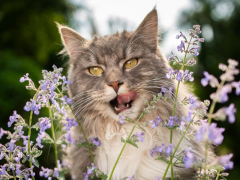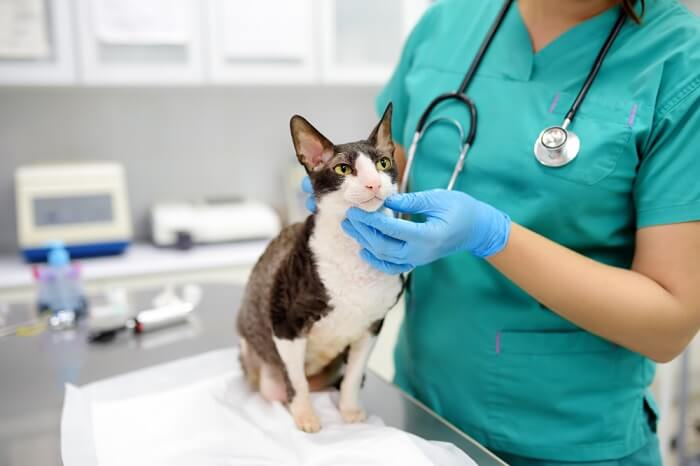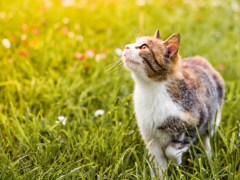
Shveyn Irina / Shutterstock.com
Lung diseases are common in cats and will often cause wheezing, coughing, and sometimes serious breathing difficulties. The most common lung condition in cats that I see as a veterinarian is feline asthma, which usually affects young adult cats. However, lung disease can be caused by a range of conditions, all with their own symptoms and treatments.
This article will cover all you need to know about lung disease in your cat, from what can cause it to symptoms, diagnosis, and treatment.
About Lung Disease in Cats
Every cell in your cat’s body needs oxygen to survive. Their airways are responsible for ensuring this happens.
Your cat’s airways are nearly identical to your own. They breathe air in through their nose, which then travels down their trachea (windpipe). As it enters the lungs, the trachea divides into the left and right bronchi, which further divides into multiple small tubes called bronchioles. At the end of the bronchioles are tiny air sacs called alveoli. The alveoli exchange oxygen and carbon dioxide between the lungs and the blood.
Your cat’s lungs have three main jobs:
- Bring air in and out of the body through breathing
- Deliver oxygen into the bloodstream
- Remove carbon dioxide from the bloodstream
What is Lung Disease?
When your cat’s lungs are healthy, they breathe easily and keep the blood full of oxygen which can be delivered to the cells. Lung disease is any condition that stops the lungs from working properly.
Disease in the lungs commonly results in difficulty breathing – bringing air in and out of the lungs. But, when it affects the smaller structures within the lungs, it can impact the exchange of oxygen and carbon dioxide.
Causes of Lung Disease in Cats

Lung disease in cats is commonly caused by inflammation, infection, and fluid in the chest. Tunatura / Shutterstock.com
Lung disease can occur for many reasons. The most common causes of lung disease in cats can be grouped into inflammation, infection, and fluid.
Inflammation
The most common lung diseases in cats are feline asthma and chronic bronchitis. They are both inflammatory conditions and usually affect younger adult cats. Feline asthma is thought to be caused by a reaction to inhaled allergens, while the cause of chronic bronchitis isn’t fully understood. Many cats will have no signs at all, or only mild symptoms daily. But they can suffer from serious flare-ups – a bit like asthma attacks in people. Corticosteroids and bronchodilators are the main form of treatment, and will usually be needed long-term.
Infection
Cats can suffer from lung infections, causing pneumonia, pyothorax (pus in the chest), and abscesses. While bacterial infections are most common, cats can also suffer from fungal, viral, and parasitic infections (such as heartworm).
Infections are diagnosed by sampling fluid from within the lungs and sending it to a lab. The sample can be cultured to identify the organism involved and how to treat it.
Fluid in the Chest
Fluid in the chest is a common cause of breathing difficulties in cats. However, it usually stems from heart disease (or, congestive heart failure) rather than lung disease. When a heart begins to fail, it struggles to pump blood around the body effectively. This leads to build-up of fluid in the lungs (pulmonary edema) or around the lungs (pleural effusion). However, fluid in the lungs can also be caused by infection, foreign bodies, or masses.
Less common causes of lung disease include inhaled irritants, parasites, cancer, chylothorax, or a congenital issue (something your cat was born with).
What are the Signs of Lung Disease in Cats?

Lung disease is common in cats and, in severe cases, can be life-threatening. Garna Zarina / Shutterstock.com
Conditions affecting your cat’s lungs will cause problems with their breathing or the oxygenation of the blood – or both. Their symptoms may include:
- Difficulty breathing
- Noisy breathing – such as wheezing
- Abnormally fast or slow breathing
- Open mouth breathing
- Coughing
- Discharge from the nose
- Lethargy, weakness, or reluctance to exercise
- Blueish tinge to areas like tongue or gums (cyanosis)
- Collapse
These clinical signs can come on suddenly (acute respiratory distress), or much more slowly over time (chronic lung disease). Cats will often have other signs of illness depending on what is going on. For instance, a cat with an infection may also have a fever and a snotty nose.
How does a Veterinarian Diagnose Lung Disease in Cats?
As a cat owner, you know your cat best. So, as a vet, my first step is listening carefully to your concerns (taking a history).
Cats will often breathe differently during an examination due to stress. This can make it hard to work out what’s normal and what isn’t, so what you’ve noticed at home is a vital part of the picture. Videos of any episodes at home can be very useful.
Next, your cat will need a thorough physical examination, from nose to tail. Your veterinarian will pay careful attention to how your cat is breathing and will listen to their lungs and heart using a stethoscope. They may hear abnormal lung sounds, such as wheezes or crackles. They will also look for clues of illness outside your cat’s chest, that is causing their breathing problems, such as heart disease.
Your veterinarian will use the information from your history and physical exam to recommend tests that may help diagnose the problem.
Blood Tests
While routine blood screens won’t diagnose lung disease definitively, they can point you in the right direction. Cats with infectious lung disease often have high levels of white blood cells, a marker of infection. Whereas cats with feline asthma might show increased eosinophils, a marker of allergic disease.
Your veterinarian may also recommend some specific blood tests. For example, tests for feline immunodeficiency virus (FIV) and feline leukemia virus (FeLV) testing, heartworm, and heart failure.
Chest X-Rays

Chest x-rays are one of the best ways to diagnose lung disease in cats. AlexandruPh / Shutterstock.com
Many lung diseases can be diagnosed (or ruled out) using an X-ray of your cat’s chest. Unless your cat is very unwell, they will need sedation or anesthesia to take high-quality radiographs.
Your veterinarian will be able to see the shape and appearance of their lungs, trachea, heart, and pleural space. They will look for masses, fluid, and signs of inflammation or infection. Chest x-rays are also particularly helpful for ruling out heart failure.
Ultrasound
Ultrasound is not very useful for looking at normal lungs, as the ultrasound waves cannot penetrate air – which your cat’s lungs should be full of! However, diseased lungs often contain areas with no or little air. This might be due to fluid in or around the lungs, masses, or a collapsed lung.
Ultrasound (or echocardiography) is also a great way of assessing your cat’s heart, as heart and lung problems are commonly linked.
Sampling Fluid from the Lungs
For many types of lung disease, getting a sample from inside the lungs is the only way to get a definitive diagnosis. This is usually done by an ‘endotracheal wash’ or ‘bronchoalveolar lavage’. Both methods involve putting sterile water into the airways and sucking it back again – with the aim of harvesting cells.
This solution (containing the cells) can then be examined under the microscope and cultured at a lab to see what type of infection may be present and the best medication to treat it.
Treating Lung Disease in Cats
Cats in acute respiratory distress will require urgent examination and treatment. Cats with chronic respiratory disease will need an ongoing plan for management of their symptoms and condition.
Emergency Treatment of Acute Lung Disease in Cats
Cats with severe respiratory distress require emergency treatment to stabilize them. This usually involves:
- Oxygen therapy: either via a face mask, nasal prongs or in an oxygen cage
- Minimal handling: stress can cause serious worsening in cats with breathing difficulty. So, every effort should be made to reduce stress until they are more stable – even if this means delaying tests or other treatments
- Bronchodilator medication: medications called bronchodilators can help to open the airways
- Steroid medication: injectable steroids can rapidly reduce inflammation in the airways and reduce an allergic response. Steroids are particularly useful in cats with asthma. However, they can worsen cats with heart failure so must only be used once this has been ruled out.
- Thoracocentesis: cats with fluid in the chest may need it drained via a needle to provide relief
Long-Term Treatment of Cats with Lung Disease

Just like us, cats with chronic breathing problems such as asthma may be prescribed an inhaler. RozochkaIvn / Shutterstock.com
What your cat needs in the long term will depend on what is causing their lung disease.
Steroids are the most common medication used in cats with lung disease. They reduce inflammation in the airways. Your cat may need a high dose initially, but this can be reduced gradually as their symptoms are controlled. Cats with chronic conditions, such as asthma or chronic bronchitis, may need low-dose steroids long-term. Bronchodilators are often used alongside steroids to open the airways.
Steroids and bronchodilators can be given in tablet, injectable, or inhaled forms, depending on what suits your cat best. However, using an inhaler will reduce their risk of side effects.
Cats with infections will also need an antimicrobial. Depending on the cause this may be antibiotics, antifungal, antiparasitic, or antiviral medications. Ideally, the choice of medication will be based on test results to identify the specific organism involved. This gives your cat the best chance of recovery while reducing antimicrobial resistance.
Depending on your cat’s condition, they may need other medications or treatments.
Preventing Lung Disease in Cats
Air quality plays a role in many lung conditions in cats, especially asthma and chronic bronchitis. Try to keep the air in your home free of mold, dust, smoke, and household irritants like incense and air fresheners. Whatever your cat’s lung condition, clear air will help them breathe more easily.
In addition, your cat should have a yearly health check with their veterinarian to pick up on any problems early, and they should be dewormed as needed to prevent parasites.
Frequently Asked Questions
How long do cats live with lung disease?
The life expectancy of cats with lung disease will depend on their condition. Cats with feline asthma or chronic bronchitis can take medication that allows them to live normal lives. But some conditions, such as lung cancer or pneumonia, can be life-threatening. Breathing difficulties should always be taken seriously, and prompt an immediate vet visit.
What are the early warning signs of lung disease in cats?
The early signs of lung disease in cats can be subtle. You might notice they are breathing faster or there is an unusual noise when they breathe. They may also tire more easily after exercise or play. As the disease progresses, they may experience a cough, difficulty breathing, or collapse. Always get any unusual symptoms checked by your vet as early as possible.
Is respiratory disease in cats fatal?
Respiratory distress can be fatal in cats. If your cat is struggling to breathe you should contact your veterinarian immediately. With emergency treatment, many cats will survive, even if they need long-term medication to keep them stable. Some conditions, such as lung cancer, may not be treatable.
-
Bovens, C. (2016). Lower airway disease in cats. Vet Times.
-
Today’s Veterinary Practice. (2022a, February 16). Treatment of feline lower airway disease.
-
Today’s Veterinary Practice. (2022b, February 17). Diagnosis of feline lower airway disease.







